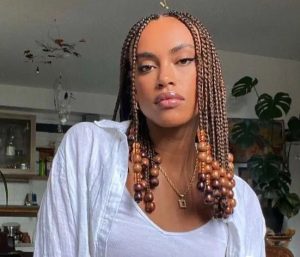What is the Oldest Known Braid?
The claim to the oldest known braid holds a bit of intrigue! Currently, there are two strong contenders:
- Venus of Willendorf: This figurine, estimated to be between 28,000 and 25,000 years old, depicts a woman with what appears to be intricately woven hair. However, some debate whether it represents actual braids or a woven basket headpiece.
- Venus of Brassempouy: Carved around 25,000 years ago, this figurine also sports sculpted hair that resembles a braided style. This one receives less debate but holds equal historical significance.
So, while we can’t definitively crown a single winner, both Venus of Willendorf and Venus of Brassempouy offer fascinating glimpses into the ancient world and hint at the long, captivating history of braiding across cultures.
Definition of a Braid
Before we embark on our quest to discover the oldest braid, let’s first define what a braid is. A braid typically consists of three or more strands of material intertwined in a specific pattern. The weaving process results in a durable and visually appealing structure, often used for practical or ornamental purposes. Also, read about Who invented braids
Historical Significance of Braids
Ancient Civilizations and Braiding
Braiding has a rich history dating back to ancient times. Archaeological evidence suggests that ancient civilizations such as the Egyptians, Greeks, and Romans practiced the art of braiding thousands of years ago. In these cultures, braids held both practical and symbolic significance.
Cultural Importance
In many cultures, braids are more than just a hairstyle; they are deeply intertwined with cultural identity and tradition. For example, among Native American tribes, intricate braided hairstyles were used to signify tribal affiliation, status, and familial ties.
Exploration of the Oldest Known Braid
Archaeological Discoveries
Archaeologists have unearthed numerous artifacts featuring braided elements, providing valuable insights into ancient braiding techniques and styles. Among these discoveries, one stands out as potentially the oldest known braid.
Scientific Analysis
Through advanced scientific techniques such as carbon dating and microscopic analysis, researchers have been able to determine the age and composition of ancient braids. These studies shed light on the materials used, the methods of braiding, and the cultural contexts in which they were created.

Braids in Ancient Cultures
Egypt
In ancient Egypt, braids were not only fashionable but also held religious and cultural significance. Elaborate braided hairstyles adorned the heads of pharaohs, queens, and commoners alike, serving as symbols of wealth, power, and beauty.
China
Similarly, in ancient China, braided hairstyles were prevalent among both men and women. Braids were often adorned with intricate ornaments and symbols, reflecting the wearer’s social status and cultural heritage.
Europe
In medieval Europe, braids were commonly worn by both nobility and commoners. Braided hairstyles varied in complexity and style, with different regions developing their unique braiding techniques and traditions.
Evolution of Braiding Techniques
Traditional Methods
Throughout history, braiding techniques have evolved and diversified, with different cultures developing their unique styles and patterns. Traditional methods often involved hand-weaving strands of hair or other materials using simple tools such as combs and needles.
Modern Adaptations
In modern times, braiding has experienced a resurgence in popularity, thanks to innovations in hair care products and styling tools. Today, braiding techniques range from classic three-strand braids to more intricate designs such as fishtail braids and Dutch braids.
Symbolism of Braids
Religious Symbolism
In many cultures, braids are imbued with religious symbolism and significance. For example, in Hinduism, the act of braiding hair is associated with spirituality and devotion, while in Christianity, braids may symbolize purity and obedience.
Social Status
Braided hairstyles have long been associated with social status and identity. In some societies, the complexity and ornamentation of a person’s braid could indicate their wealth, rank, or marital status.
Preservation of Ancient Braids
Museums and Exhibits
Many ancient braids have been preserved in museums and cultural institutions around the world, allowing researchers and enthusiasts to study and appreciate their beauty and craftsmanship.
Conservation Efforts
Efforts are underway to preserve and protect ancient braids from decay and degradation. Conservationists use specialized techniques to stabilize and restore these fragile artifacts, ensuring that they remain intact for future generations to enjoy.
For more interesting information visit our website urbansoutfitter.com
Conclusion
In conclusion, the quest to uncover the oldest known braid takes us on a fascinating journey through time and across cultures. Braids, with their timeless beauty and cultural significance, continue to captivate and inspire us today. By exploring the origins, evolution, and symbolism of braids, we gain a deeper appreciation for this ancient art form and its enduring legacy.
FAQs
Q: How old is the oldest known braid?
A: The exact age of the oldest known braid is difficult to determine, but archaeological evidence suggests that braiding dates back thousands of years.
Q: What materials were used to create ancient braids?
A: Ancient braids were often made using natural materials such as hair, wool, silk, and plant fibers.
Q: Are braids still culturally significant today?
A: Yes, braids continue to hold cultural significance in many societies around the world, serving as symbols of tradition, identity, and beauty.
Q: Can anyone learn how to braid?
A: Yes, braiding is a skill that can be learned with practice and patience. There are countless tutorials and resources available for those interested in mastering the art of braiding.
Q: What are some modern variations of braided hairstyles?
A: Modern variations of braided hairstyles include fishtail braids, French braids, Dutch braids, and waterfall braids, among others.
